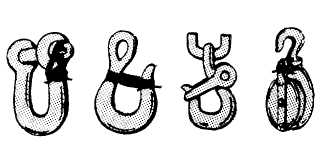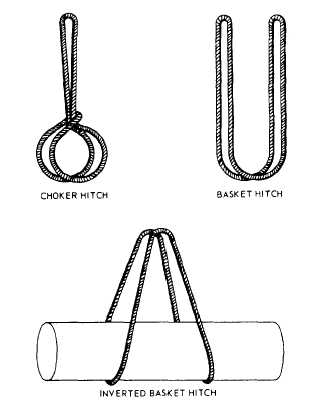
Figure 4-35. - Mousing.
or 10 wraps around both sides of the hook. To finish off, make several turns with the yarn or wire around the sides of the mousing, and then tie the ends securely (figure 4-35).
Shackles are moused when there is danger of the shackle pin working loose and coming out because of vibration. To mouse a shackle, simply take several turns with seizing wire through the eye of the pin and around the bow of the shackle. Figure 4-35 shows what a properly moused shackle looks like.
HOISTING
LEARNING OBJECTIVE: Upon completing this section, you should have a basic understanding of hoisting, handsignals used in lifting loads, and some of the safety rules of lifting.
In lifting any load, it takes two personnel to ensure a safe lift: an equipment operator and a signalman. In the following paragraphs, we will discuss the importance of the signalman and a few of the safety rules to be observed by all hands engaged in hooking on.
SIGNALMAN
One person, designated as the and one person only, should be official signalman for the operator of a piece of hoisting equipment, and both the signalman and the operator must be thoroughly familiar with the standard hand signals. When possible, the signalman should wear some distinctive article of dress, such as a bright-colored helmet. The signalman must maintain a position from which the load and the crew working on it can be seen, and also where he can be seen by the operator.
Appendix III at the end of this TRAMAN shows the standard hand signals for hoisting equipment. Some of the signals shown apply only to mobile equipment; others, to equipment with a boom that can be raised, lowered, and swung in a circle. The two-arm hoist and lower signals are used when the signalman desires to control the speed of hoisting or lowering. The one-arm hoist or lower signal allows the operator raise or lower the load. To dog off the load and boom means to set the brakes so as to lock both the hoisting mechanism and the boom hoist mechanism. The signal is given when circumstances require that the load be left hanging motionless.
With the exception of the emergency stop signal, which may be given by anyone who sees a necessity for it, and which must be obeyed instantly by the operator, only the official signalman gives the signals. The signalman is responsible for making sure that members of the crew remove their hands from slings, hooks, and loads before giving a signal. The signalman should also make sure that all persons are clear of bights and snatch block lines.
ATTACHING A LOAD
The most common way of attaching a load to a lifting hook is to put a sling around the load and hang the sling on the hook (figure 4-36). A sling can be made of line, wire, or wire rope with an eye in each

Figure 4-36. - Ways of hitching on a sling.
Continue Reading